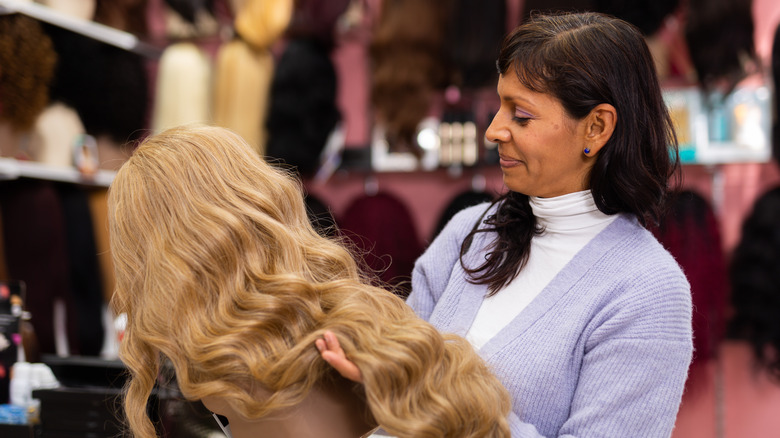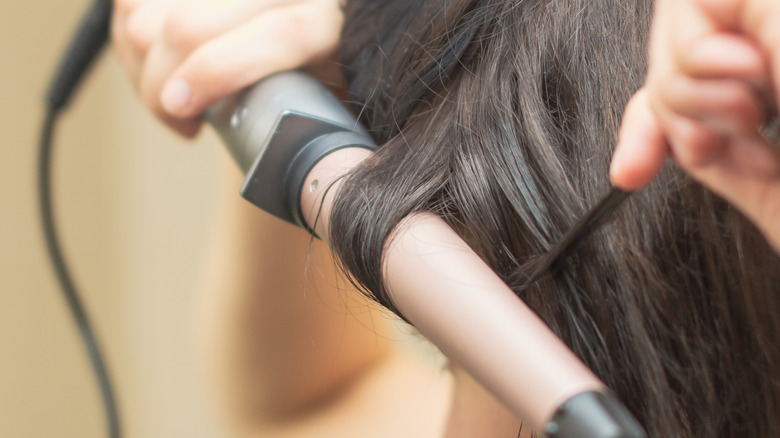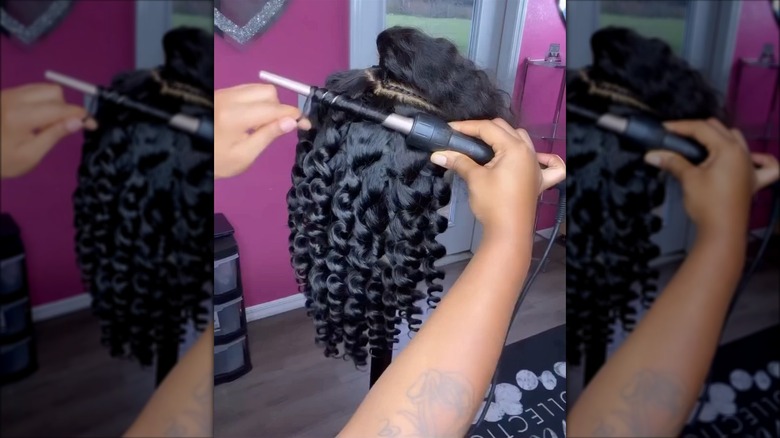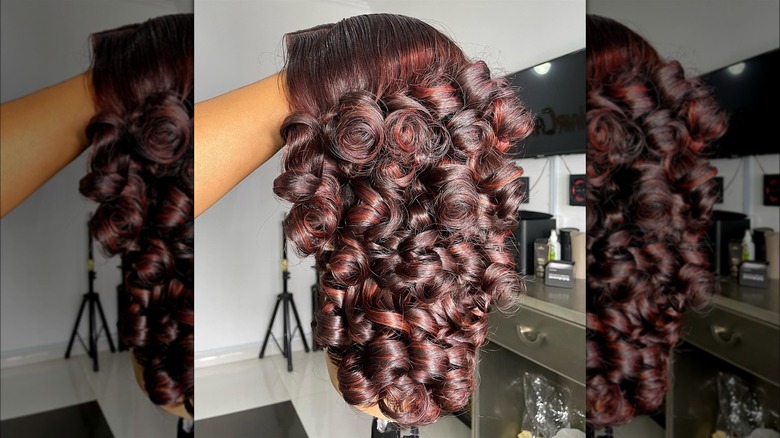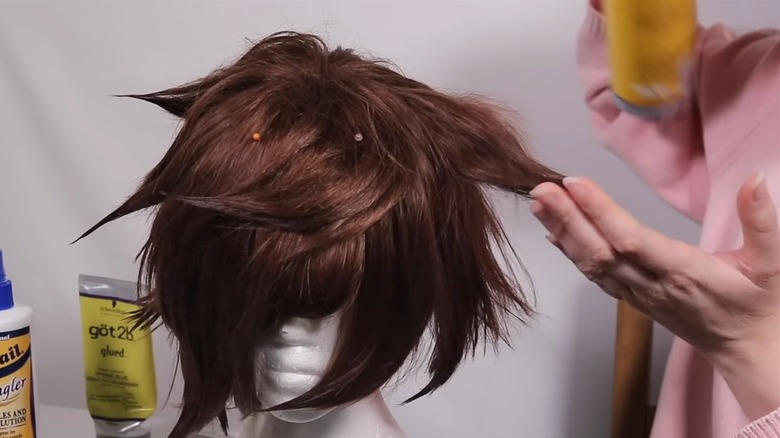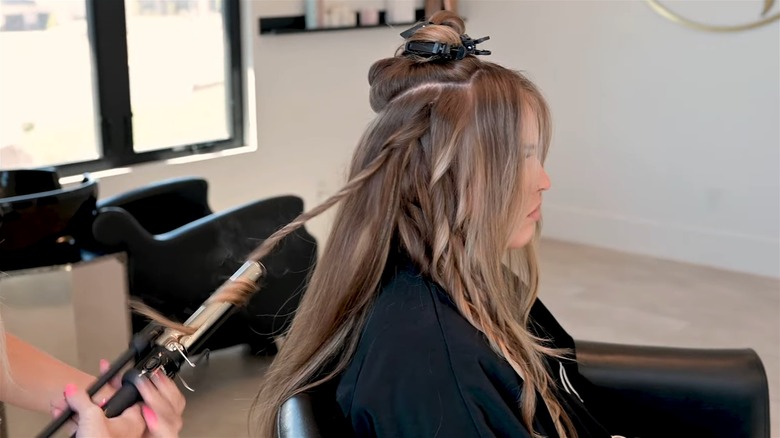Our Best Tips For Curling Synthetic Hair
Over the years, synthetic hair has become more available and more affordable. Because of that, more and more of us are turning to things like hair extensions or wigs to get the look we want. Plenty of celebrities have spoken out about their love of wigs, and many have done the same about hair extensions. In fact, actor and singer Kristin Chenoweth has admitted that her hair extensions actually saved her life, explaining during an appearance on "Watch What Happens Live" that her extensions encouraged a hairline fracture on her head not to open too much. "So anybody who wants to get hair extensions should, for your health," she joked.
While we wouldn't go as far as Chenoweth and say anyone needs synthetic hair, it certainly does have its benefits. The most obvious is its ability to give confidence to people who are struggling with their hair, as well as making hairstyling so much easier. But is it that easy? There are a lot of questions when it comes to synthetic hair maintenance, including if it can be curled. Well, we're here to tell you that it (usually) can, but there are a few tips to remember if you want to do it right.
First things first, though, we should clarify that synthetic doesn't mean all wigs and extensions. Synthetic literally means man-made hair, usually created using Nylon, Polyester, or Acrylic. Some hairpieces are made of human hair, so that's not what we're referring to when we say synthetic.
Turn down the heat on synthetic hair for the best curling results
The first thing to do before curling any form of synthetic hair is to check the label. A lot of modern synthetic hair should be okay to curl, but it's always worth checking the packaging for any warnings, as not all synthetic pieces are heat-resistant. The label may also give you tips on how to curl your hairpiece, as well as recommend the ideal temperature to use. If it doesn't though, the best tip is to turn down the heat compared to the intensity you may use on human hair. While the optimum temperature for curling tools on natural hair is around 350 degrees Fahrenheit, beauty expert and celebrity stylist David Lopez recommended to Byrdie not to go over 320 degrees when it comes to curling synthetic hair.
This is because anything hotter than that could end up actually melting the plastic used to make your synthetic tresses. And that's not good. Not only would melted hair not look its best (seriously, who wants to be walking around with melted locks?) you could also end up permanently ruining the hair, which isn't ideal when you may have paid a pretty penny for your confidence-boosting hairpiece.
Invest in a mannequin head
If you're looking to curl synthetic hair that's not already on your head (some extensions, for example, are semi-permanently attached to your natural hair), the best results will come from investing in a mannequin head. There are a few different versions of this on the market (you may also see it referred to as a wig rest or wig stand), but what you ideally want is something in the shape of a human head that will hold your hairpiece in place. A wig will sit directly on the scalp, or, if you're using extensions, a Styrofoam head will allow you to pin the extensions to it.
There are several benefits to a mannequin head when it comes to curling your synthetic hair. Not only will it hold the hair firm so it's not slipping in and out of your curling tool while you're working, but it will also give you a good idea of how the finished product will look when it's placed on your head. Mannequin heads can also be great for storing your hairpieces once you're done with them. Rather than creating a stunning curl and then cramming your synthetic locks into a box, allowing it to stay on something in the shape of a head will help it keep the style longer. You may even find you get several wears out of one curling session that way.
Don't forget to detangle!
Just like natural hair, you must get rid of any tangles or knots that may be in your synthetic hair before you start the curling process. You'd be forgiven for believing that synthetic hair, because of its plastic components, wouldn't get as knotty as natural hair, but that's not necessarily true — especially if you don't store your hairpieces separately or they tend to get bunched up.
The best way to do this is to place your synthetic hair on your mannequin head (if you have one) or, if you don't, hold it in one hand so it can dangle freely, then you can tackle any knots with the other hand. Next, run a wide-tooth comb or a specific wig brush through the hair, as these are less likely to damage the fibers. Start at the tips before working upwards towards the roots. Keep running your comb or wig brush through until the hair is smooth and tangle-free. Make sure you're gentle with the hair though and aren't pulling too hard, as too much force may ruin the strands or even pull hair out.
Make sure you're only using products compatible with synthetic hair
We know, there's a big temptation to treat synthetic hair like natural hair. After all, it's supposed to look just like natural hair, right? But it's important to remember that it's not the same thing. That's why any products you're using during the curling process must be compatible with synthetic hair to keep it looking as good as it can.
A couple of products that will come in handy are heat protectant spray (which will help protect the fibers from the heat) and a hairspray to help hold the curl. But both need to have been specifically designed for synthetic hair. There's quite a range of hair products created for use on non-natural hair out there, and they usually don't have the same parabens or sulfates that a lot of standard hairsprays have. Standard hair products may end up damaging the synthetic fibers and could also cause a build-up of product, resulting in your synthetic hair not looking its best. When it comes to using the synthetic hair versions of these products though, you'll still need to make sure you're using them sparingly to prevent the dreaded build-up that would usually be removed from natural hair with a clarifying shampoo.
Section off your hair for better curls
Another great tip for curling your synthetic locks is to make sure you're curling in sections, with six sections on either side of the head usually working for most hair types. Talking to Byrdie, David Lopez recommended making each section around the same size as the barrel of your curling iron or curling wand (remember a wand doesn't have a clamp like an iron does). That will allow each strand of the synthetic hair to get the same amount of heat during the curling process, further minimizing the risk of the heat damaging the plastic in it. It also allows you to get closer to the root for each strand and gives you better access to each part of your hair, as you won't have to fight through masses of hair to curl each part.
Another big benefit to sectioning the hair is that it will also give you the chance to test out your curling technique. Try a section of hair that will be towards the back of your head and won't be quite as visible as anything from the top layer at the front first. That way, you can see how that section reacts to the heat temperature and styling products you're using, and you can adjust things if needed.
